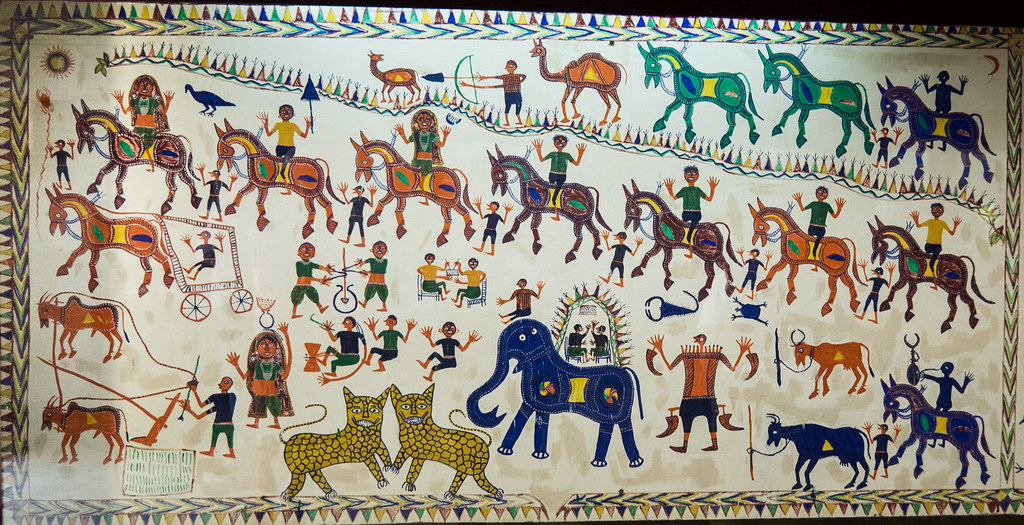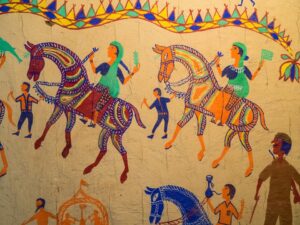Pithora art: Depicting different hues of tribal life

Pithora paintings, traditionally done on walls, are characterised by seven horses representing the seven hills that surround the area bordering Gujarat and Madhya Pradesh
“Be it a depiction of countryside, weddings, festivals or celebrations of tribals, Pithora art celebrates different realities of rural life. It is like photographs of our daily lives, only hand-made and not clicked,” says Paresh Rathwa, a 51-year-old artist of Pithora paintings from Chhota Udepur, Gujarat, who has been giving classes in Pithora art online and offline.
The paintings, traditionally done on walls, are characterised by seven horses representing the seven hills that surround the area bordering Gujarat and Madhya Pradesh, which is home to the Rathwa and Bhilala communities that make these paintings. “The paintings are rich with imagery from their everyday life – elephants, men, women, arms and musical instruments, besides weddings, festivals and celebrations,” Rathwa explains.
He goes on to explain that the paintings are usually done on cloth, paper, cardboard and walls with natural and synthetic colours. Traditionally, Pithora like every other form of painting originated on the walls of tribal households.
Historically derived from cave, wall and rock paintings, this art is heavily inspired from Gujarat, has spiritual and mythological relevance to indigenous tribes of Madhya Pradesh which has slowly transformed into a vibrant occupation of the Bhilalas or Rathwas.
How the paintings are made
The process begins with lipai (preparing the canvas) which traditionally comprises setting the background of walls with dung, water and chuna (limestone). Painted in spectacular and vivid reds, greens, oranges, blues and pinks- birds, animals, trees and the cosmos – all find their representation through these paintings. It is considered sacred to paint horses, the sun, and the moon which, are believed to be the three lucky mascots in Bhilala mythological stories, characterising and distinguishing these paintings.
Daily activities of rural life such as farming, hunting, ploughing, and exuberance in festivities like dancing and singing in revelry, depicting social cohesion are exhibited through colours and imagination with highest reverence to Pithora Dev (deity) and local gods.
The many patterns of Pithora painting
A beautiful melange of colours inspired by nature is seen in-wall and paper paintings, but each pattern differs from the other. An important feature of authentic Pithora art is that no two paintings are ever similar and artists take care of this ‘unique selling point’ of their skill with utmost precision.
“Every artist leaves a distinct mark on each of his paintings to signify his intellectual and creative rights over the murals, thereby making them unique in their own way by using different colour combinations, floral patterns and symmetry in murals,” explains Rathwa.
Choosing the subjects
The backgrounds are white or crème in colour but could be stark red for a rustic mud colour appeal suiting contemporary tastes. Tribal chores are depicted beautifully on these paintings which have over time become quite a home decor product finding distant refuge in urban homes.
“The authentic portrayal of the village and tribal life is done ecstatically to present hardship and occasional festivity, thus representing the co-existence of hope and despair in tribal lives, through the depiction of daily chores and celebrations at the same time, making a painting complete,” adds Rathwa.
The pricing
“Each painting without frames is priced at INR 500-600, and prices vary depending on the socio-economic context of markets,” explains Goyal, who helps the painters sell their paintings online as well as in local markets. Realising the livelihood advantage associated with Pithora art, Rathwa and his family now practice this art form on floor, paper, walls, cloth, canvas and wood.
During weddings in the village and some urban homes, classic derivations of Pithora work are more in demand and people also contract a group of artists for two to three days to decorate their walls.
Taking art beyond boundaries
Paresh Rathwa has also been awarded with Shikhar Samman and Ahalya Samman by Madhya Pradesh government in 2018 and 2019 respectively. He was invited on a presidential delegation to Australia for a workshop with Australian aboriginal painters and Indian tribal artists.
A group of artists led by him presently work with the Adivasi Lok Kala Academy in Madhya Pradesh’s capital Bhopal. Their works have been displayed in galleries and museums of Europe, Australia and the US. Their painting ‘Story of the Jungle’ sold at auctioneer Sotheby’s in??? for how much and when??.
Changing canvas
In 2019, Shivani Goyal, a college student from Delhi, along with five of her friends started an online campaign to promote the art. As part of their campaign, a Facebook page dedicated to Pithora artists was launched and an official email created to welcome inquiries, with a website now under construction. It was through one of these that Rathwa got a chance to visit Delhi and conduct a workshop with the students.
Goyal, who started the initiative, says, “Whenever we talk about tribal art, we talk of Madhubani and Warli, which are well known, but these art forms too should be popularised. The first step is to make people aware of its existence, which we started doing through social media. Secondly, we are trying to motivate the artists to shift their canvas from walls to items that can be sold.”
So far, they have approached around 10 artists from the district to push the art form further. Through them, they plan to network with other artists and motivate children and youngsters to learn the art form.
While Rathwa, Goyal and other artists say that the best artworks are only created on a mud wall or floor, they have also started painting on bags, walls, bedsheets, table-clothes and even costumes. “It is important to expand our canvas in order to sustain. We feel happy that or paintings are now printed and sometimes handmade on designer bags and other luxury products. We get paid well and for these and hope to use this money in sustaining and reviving this artform,” says Rathwa, who is tirelessly to complete work on a luxury foreign brand costume currently.










